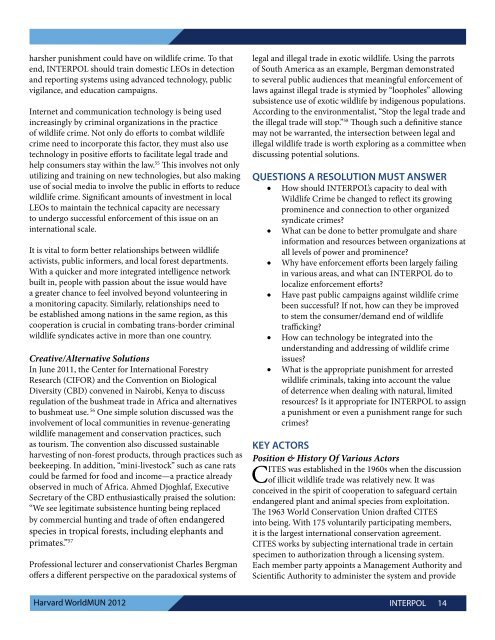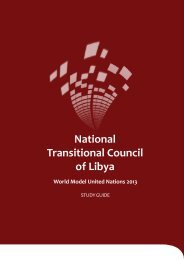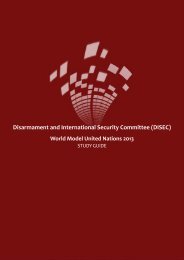INTERPOL - World Model United Nations
INTERPOL - World Model United Nations
INTERPOL - World Model United Nations
Create successful ePaper yourself
Turn your PDF publications into a flip-book with our unique Google optimized e-Paper software.
harsher punishment could have on wildlife crime. To that<br />
end, <strong>INTERPOL</strong> should train domestic LEOs in detection<br />
and reporting systems using advanced technology, public<br />
vigilance, and education campaigns.<br />
Internet and communication technology is being used<br />
increasingly by criminal organizations in the practice<br />
of wildlife crime. Not only do eorts to combat wildlife<br />
crime need to incorporate this factor, they must also use<br />
technology in positive eorts to facilitate legal trade and<br />
help consumers stay within the law. 55 is involves not only<br />
utilizing and training on new technologies, but also making<br />
use of social media to involve the public in eorts to reduce<br />
wildlife crime. Signicant amounts of investment in local<br />
LEOs to maintain the technical capacity are necessary<br />
to undergo successful enforcement of this issue on an<br />
international scale.<br />
It is vital to form better relationships between wildlife<br />
activists, public informers, and local forest departments.<br />
With a quicker and more integrated intelligence network<br />
built in, people with passion about the issue would have<br />
a greater chance to feel involved beyond volunteering in<br />
a monitoring capacity. Similarly, relationships need to<br />
be established among nations in the same region, as this<br />
cooperation is crucial in combating trans-border criminal<br />
wildlife syndicates active in more than one country.<br />
Creative/Alternative Solutions<br />
In June 2011, the Center for International Forestry<br />
Research (CIFOR) and the Convention on Biological<br />
Diversity (CBD) convened in Nairobi, Kenya to discuss<br />
regulation of the bushmeat trade in Africa and alternatives<br />
to bushmeat use. 56 One simple solution discussed was the<br />
involvement of local communities in revenue-generating<br />
wildlife management and conservation practices, such<br />
as tourism. e convention also discussed sustainable<br />
harvesting of non-forest products, through practices such as<br />
beekeeping. In addition, “mini-livestock” such as cane rats<br />
could be farmed for food and income—a practice already<br />
observed in much of Africa. Ahmed Djoghlaf, Executive<br />
Secretary of the CBD enthusiastically praised the solution:<br />
“We see legitimate subsistence hunting being replaced<br />
by commercial hunting and trade of oen endangered<br />
species in tropical forests, including elephants and<br />
primates.” 57<br />
Professional lecturer and conservationist Charles Bergman<br />
oers a dierent perspective on the paradoxical systems of<br />
legal and illegal trade in exotic wildlife. Using the parrots<br />
of South America as an example, Bergman demonstrated<br />
to several public audiences that meaningful enforcement of<br />
laws against illegal trade is stymied by “loopholes” allowing<br />
subsistence use of exotic wildlife by indigenous populations.<br />
According to the environmentalist, “Stop the legal trade and<br />
the illegal trade will stop.” 58 ough such a denitive stance<br />
may not be warranted, the intersection between legal and<br />
illegal wildlife trade is worth exploring as a committee when<br />
discussing potential solutions.<br />
QUESTIONS A RESOLUTION MUST ANSWER<br />
!" How should <strong>INTERPOL</strong>’s capacity to deal with<br />
Wildlife Crime be changed to reect its growing<br />
prominence and connection to other organized<br />
syndicate crimes?<br />
!" What can be done to better promulgate and share<br />
information and resources between organizations at<br />
all levels of power and prominence?<br />
!" Why have enforcement eorts been largely failing<br />
in various areas, and what can <strong>INTERPOL</strong> do to<br />
localize enforcement eorts?<br />
!" Have past public campaigns against wildlife crime<br />
been successful? If not, how can they be improved<br />
to stem the consumer/demand end of wildlife<br />
tracking?<br />
!" How can technology be integrated into the<br />
understanding and addressing of wildlife crime<br />
issues?<br />
!" What is the appropriate punishment for arrested<br />
wildlife criminals, taking into account the value<br />
of deterrence when dealing with natural, limited<br />
resources? Is it appropriate for <strong>INTERPOL</strong> to assign<br />
a punishment or even a punishment range for such<br />
crimes?<br />
KEY ACTORS<br />
Position & History Of Various Actors<br />
CITES was established in the 1960s when the discussion<br />
of illicit wildlife trade was relatively new. It was<br />
conceived in the spirit of cooperation to safeguard certain<br />
endangered plant and animal species from exploitation.<br />
e 1963 <strong>World</strong> Conservation Union draed CITES<br />
into being. With 175 voluntarily participating members,<br />
it is the largest international conservation agreement.<br />
CITES works by subjecting international trade in certain<br />
specimen to authorization through a licensing system.<br />
Each member party appoints a Management Authority and<br />
Scientic Authority to administer the system and provide<br />
Harvard <strong>World</strong>MUN 2012 <strong>INTERPOL</strong> 14

















